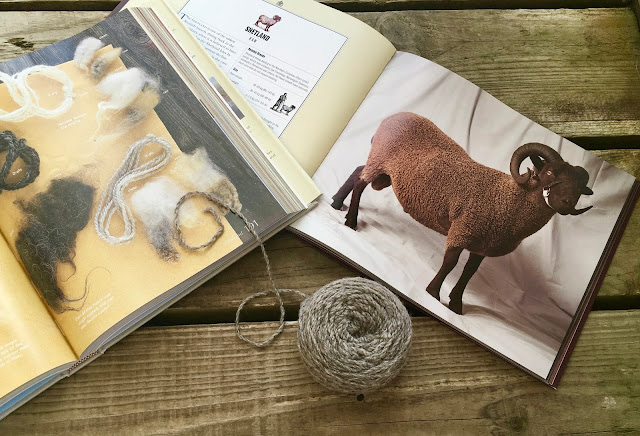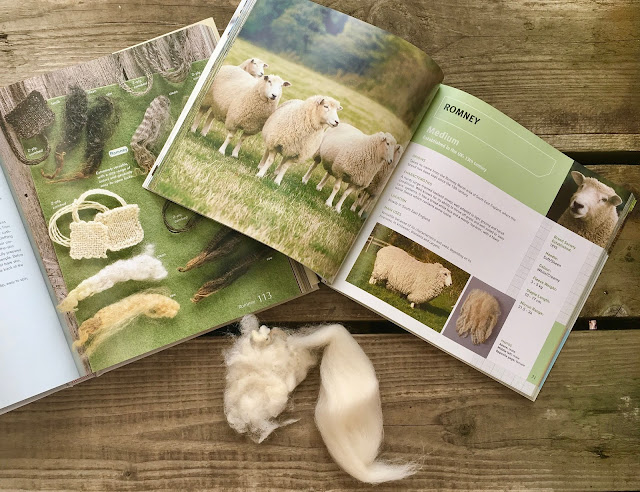 |
| Book titles and authors: The Fleece and Fibre Source Book Deborah Robson and Carol Ekarius Beautiful Sheep Kathryn Dun British Sheep & Wool The British Wool Marketing Board |
Britain has a rich heritage when it comes to sheep husbandry and fibre crafts. It’s wonderful to see so much renewed interest in the traditional breeds.
With so many breeds however, it can be hard to know which fibre is right for a given project: some are hard wearing but rough against the skin, while others are among the softest in the world, but can’t take much wear.
With so many breeds however, it can be hard to know which fibre is right for a given project: some are hard wearing but rough against the skin, while others are among the softest in the world, but can’t take much wear.
I’ve rounded up a beginner’s guide to some of my favourites, to help you get your bearings and shed a bit of light on what makes British breeds so special.
If you read to the end, there’s a giveaway too if you'd like to win a box of knitting goodies!
If you read to the end, there’s a giveaway too if you'd like to win a box of knitting goodies!
Some of you may already know that I kept a small flock of Shetland sheep, so it’s no surprise that this breed is at the top of my list.
Shetland
Description: A small hardy hill breed with fine bone structure. Rams usually have rounded horns.
Uses: A Shetland’s fleece can be used to produce fine yarns suitable for lacework, most famous for it's use in beautiful fair isle sweaters. The fineness and the wide range of natural shades has led to Shetland being the wool of choice for sweaters through to traditional tweed.
Characteristics: With an average fibre diameter in the range of 20-30 microns, Shetland wool can be exceedingly fine for a British breed. Known for the wide range of colours. Staple length for coloured fleece is between 6 to 12 cm.
Wensleydale
Description: A distinctive sheep, the Wensleydale has blue legs, ears and face, with a long, curly lustrous fleece. It is a large, bold sheep, but it is one of the UK’s rarest breeds.
Uses: The wool from this particular breed is often blended with finer, but shorter stapled wools for a stronger yarn. Ideal for hand-spinning and hand-felting, it is used in a number of crafts, including rug making, knitting and crochet.
Characteristics: Wensleydale wool is arguably the finest, most lustrous long wool in the world. This is because the breed has an unusual feature in their DNA known as “central checking”, which prevents kemp, or coarse fibres, from being produced. This means that purebred sheep will produce completely kemp-free fleece. The staple length is between 15 -30 cm.
Masham
Description: Mashams are a cross breed originating in North Yorkshire. The progeny of a Teeswater ram and a Dalebred or a Swaledale ewe.
Uses: Masham wool is good for those who want to get started spinning their own yarn due to its good staple length. Despite this, Masham isn’t the softest wool around, so you’ll usually find it used in a blend with softer fibres, or used in carpets.
Characteristics: The Masham is a hardy sheep, with a lustrous soft fleece and a staple length of between 12 and 25 cm.
Herdwick
Description: Perhaps the hardiest British breed, the Herdwick can survive on high ground, like the Lake District fells. Born with a black fleece, they go grey as they get older, but they usually have a white head and legs.
Uses: Herdwick wool is best suited for woven outerwear, hard-wearing carpets, and for filling furniture and mattresses. It does have a reputation for being harsh against the skin, but it’s great for accessories.
Characteristics: Their kemp fibres increase with age, making the wool brittle and coarse, so it’s never been too popular with knitters and dyers. Staple length is between 10 and 20 cm.
Lincoln Longwool
Description: A rare native sheep, the Lincoln Longwool is the largest British breed. It was bred, way back in the 1700s as a wool sheep, but it later became a dual-purpose breed. It is a docile sheep with a white face, dark ears and a broad forelock of wool that falls in it's face.
Uses: It has a strong and durable fibre, making it suitable for use in rugs, bags, cushions and outerwear.
Characteristics: Popular with hand spinners, especially the wool from Lincoln lambs. It is naturally a marbled grey, so is great for creating naturally variegated yarns and fabrics. It has a staple length between 15 -30 cm.
Romney
Description: Named after the Romney Marsh area in south east England. The Romney is a large sheep with a calm disposition.
Uses: Fleeces vary in fineness from next to the skin softness to courser more suited to upholstery purposes and floor coverings. This demi-lustrous fibre is a very popular and versatile fibre and works well for knitting, spinning, and weaving.
Characteristics: Romney fleeces are generally of a uniform and consistent quality from top to tail. The staple length is between 10 and 20.5 cm.
Uses: Fleeces vary in fineness from next to the skin softness to courser more suited to upholstery purposes and floor coverings. This demi-lustrous fibre is a very popular and versatile fibre and works well for knitting, spinning, and weaving.
Characteristics: Romney fleeces are generally of a uniform and consistent quality from top to tail. The staple length is between 10 and 20.5 cm.
********
If you’re a wool lover, the kind people over at herdy®sleep are giving away a bundle of knitting goodies! As keen supporters of traditional British crafts and breeds, they use a full herdwick fleece in each of their handmade luxury mattresses.
This giveaway includes the following:
Herdy Pattern Booklet which includes the following 5 patterns:
rucksack
cushion cover
hot water bottle cover
childs jumper
a beanie hat
x4 balls of Herdy chunky 100% British wool
x1 pair of bamboo knitting needles
x1 Herdy tape measure
*******
The Giveaway has ended.
The Giveaway has ended.








